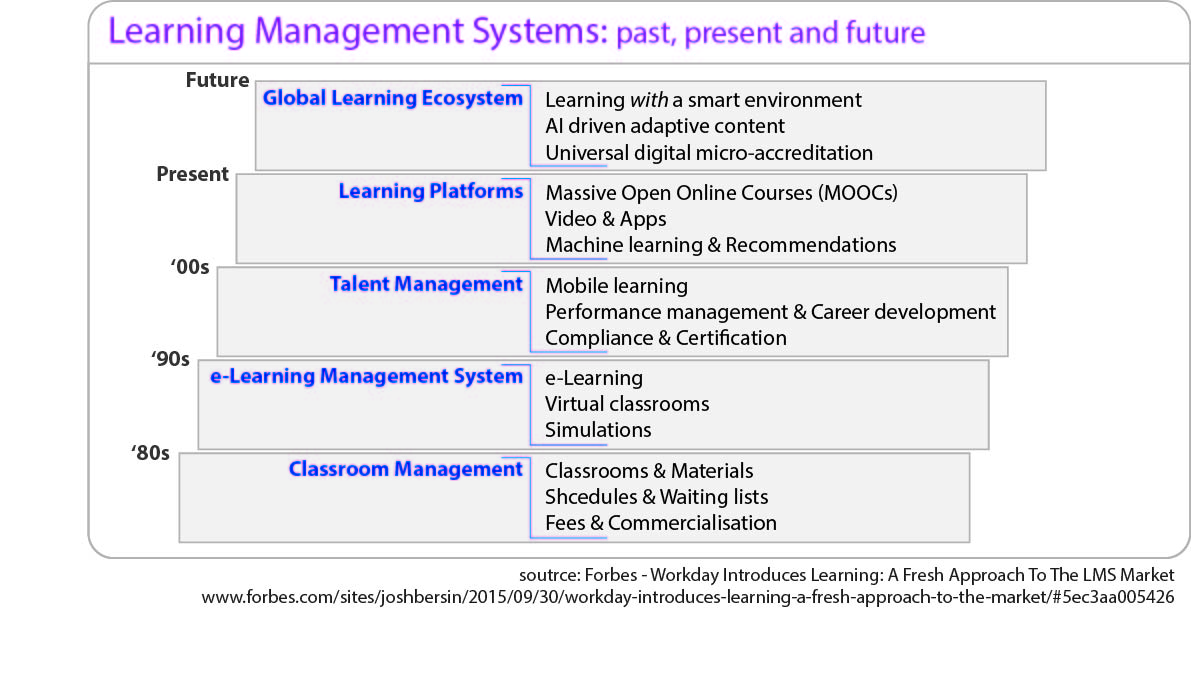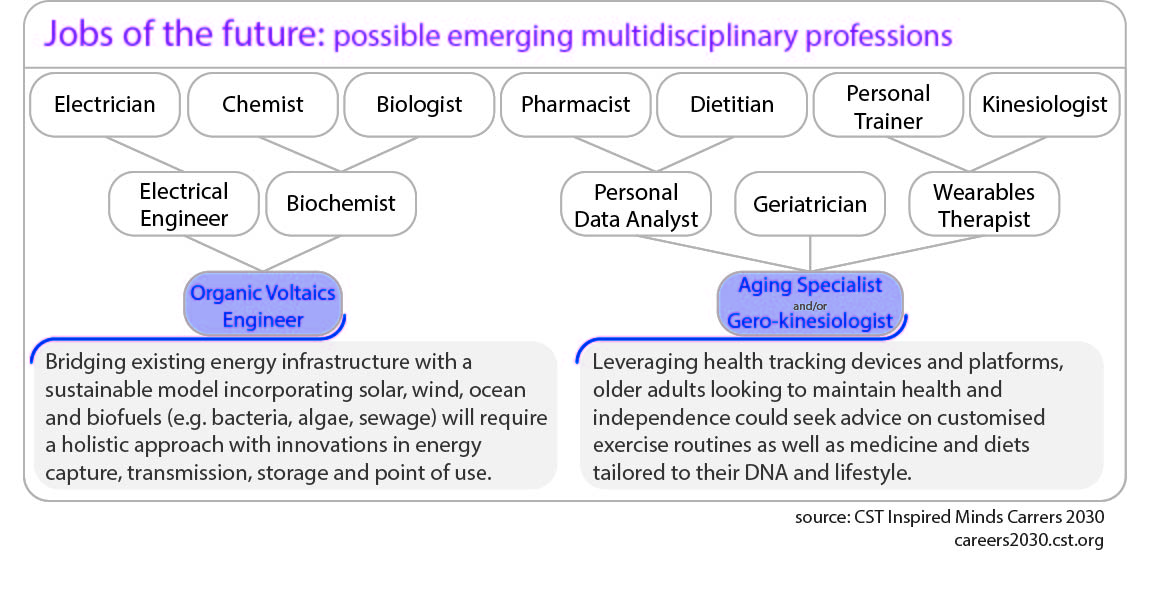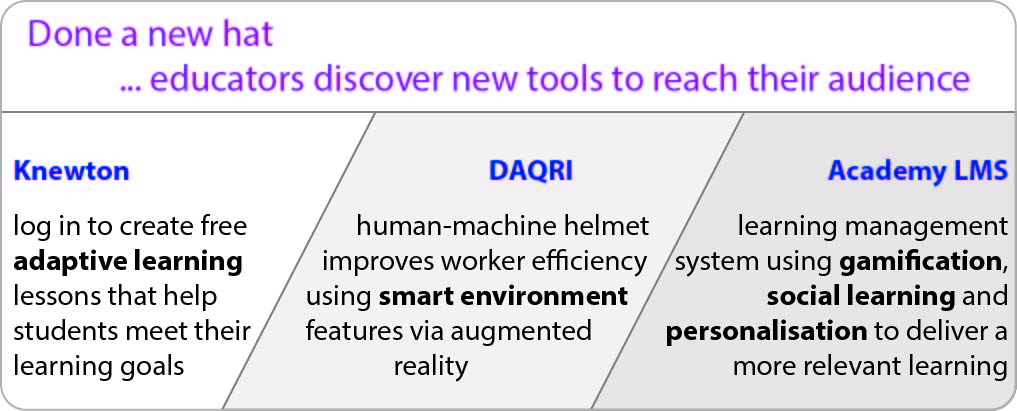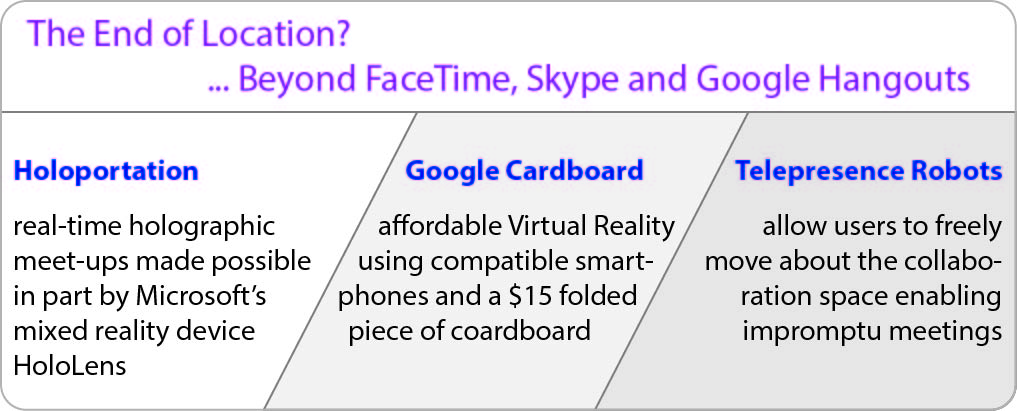The Future of Learning and Training: Environmental Scan

PDF: The Future of Learning and Training: Environmental Scan
On this page
Executive Summary
The Changing Landscape
Learning New Skills for a New Economy
Discovering Social-Immersive Learning
A Digital Learning Ecosystem is Emerging
Conclusion: A Lifelong Learning Journey
Footnotes
Executive Summary
The earners of the future may no longer be able to rely solely on education acquired in today’s educational institutions to take them throughout their careers. They will need to adapt faster to a rapidly changing economy and consider leveraging on-demand, just-in-time learning processes to stay relevant. Rapid technological advancements will transform existing jobs, shifting the demand for skills and creating entire new professions. This paper explores some of the driving changes impacting learning and training from the lens of the employee and employer, and looks at new technologies. As agents of change in the job market as well as in the learning and training industries. Innovations in the field of education, either in K-12, post-secondary or professional development, are considered as possible pioneering achievements that could eventually be applied and adopted more broadly. The goal of this document is to explore possible new models of learning and training in order to assist in developing forward looking policy.
The Changing Landscape
The needs of students and employers are changing. Jobs are being unbundled into their essential tasks due to the increases in technologies like telepresence and operations like subcontracting. Web-based freelancing sites are providing employers and entrepreneurs a platform to connect and negotiate micro-contracts or tasks across the globe. These range from 5 cent tasks requiring moments of unskilled work, to highly skilled contracts from independent professionals. Organisations are reconfiguring positions in order to leverage Artificial Intelligence (AI), robotics and outsourced cheaper labour. Categorizing in generic boxes or using diplomas to narrow applicant pools is a common time saving HR practice. Diplomas and degrees, once(link is external) a proxy for qualification, may become less important in the hiring process. AI will bring speed, precision and tirelessness to the hiring process, thoroughly vetting thousands of candidates at a lower cost and providing new ways to quantify skills, experience, reputation, etc. In the future, demonstrating competency may become interlinked as on-the-job-training and HR practices merge on web-based employment platforms(link is external) (e.g. Workday).
Over the next 15 years the way we learn has the potential to be completely transformed, creating a society of perpetual or sustained learning. Changes in learning are closely aligned to the rapid rate of technology development, information accessibility, social change and deepened curiosity.
Learning Management Systems (LMS) have undergone drastic change since they were first developed. In parallel to these evolving learning platforms, human resources is being digitised and automated. Workday Learning, a new LMS from Workday, offers organisations an employee development platform integrated to Workday’s unified suite including human resources and financial management applications.
Figure 1 – Learning management systems: past, present and future

80’s – Classroom management
Classrooms and materials
Schedules and waiting lists
Fees and commercialization
90’s – e-Learning management system
e-Learning
Virtual classrooms
Simulations
00’s – Talent Management
Mobile learning
Performance management and career development
Compliance and certifications
Present – Learning platforms
Massive open online courses (MOOCs)
Video and apps
Machine learning and recommendations
Future – Global learning ecosystem
Learning with a smart environment
AI driven adaptive content
Universal digital micro-accreditation
Source: Forbes – Workday Introduces Learning: A Fresh Approach to the LMS market.
Professionals have always needed to collaborate but as new technologies are introduced into industries, multidisciplinary careers might be an area of job growth. Careers in transformed or entirely new industries will require equally modernized learning paths.
Figure 2 – Jobs of the future: Possible emerging multidisciplinary professions

Possible profession: Organic Voltaic Engineer
Description: Bridging existing energy infrastructure with a sustainable model incorporating solar wind, ocean and biofuels (e.g. bacteria, algae, sewage) will require a holistic approach with innovation in energy capture, transmission, storage, and point of use.
Possible disciplines required: Electrical engineer (electrician) and Biochemist (Chemist and Biologist)
Possible profession: Aging Specialist and/or Gero-kinesiologist
Description: Leveraging health tracking devices and platforms, older adults looking to maintain health and independence could seek advice on customized exercise routines as well as medicine and diets tailored to their DNA and lifestyle.
Possible disciplines required: Personal Data Analyst (Pharmacist and Dietian), Geriatrician, and Wearables Therapist (Personal Trainer and Kinesiologist)
Source: CST Inspired minds Careers 2030 – careers2030.cst.org
Learning New Skills for a New Economy
What we learn is shifting
AI enabled robotics are versatile, cost effective additions to the workforce. As people are shifted away from existing positions, what new challenges will they undertake?
A rapidly evolving economy driven by new technologies (e.g. synthetic biology, nanotechnologies, neuroscience) will require entirely new skills. Just as repetitive manual tasks are being replaced by robotics; repetitive cognitive tasks will be replaced by AI. Those displaced in the workforce will need to re-train or re-examine how they can participate in the new economy.
Breaking down disciplinary barriers
- The emphasis on STEM (Science, Technology, Engineering and Mathematics) fields is shifting towards STEAM (Arts) and eventually STEAMED (Entrepreneurial, Design). Along with these fields, creativity, expertise, relationship and communication skills will continue to set people apart from AI.
- While these skills may be essential for highly paid professionals, for many lower wage positions the new learning model may prize collaboration and human-machine teamwork.
Learning how to deploy and employ new technologies
- Successful businesses will seek to train and promote rapid adaptation and deployment of readily available innovations in automation. Cloud computing has transformed the deployment cycle of innovation, allowing new AI software to be deployed worldwide(link is external) in moments.
- As the entire economy transitions, opportunities in every occupation and at every level will be seized by those willing to learn and explore practical applications of new technologies.
Figure 3 – Artificial Intelligence in White Collar Positions
![Ross: Legal Assistant Quill: Robot writer Betterment: Automated investment services Watson: Medical advisor on matters relating to oncology 2014: Canada’s Video game industry hired 3,900 new employees (FTEs), up 24% from the previous year. Canada had the largest creative economy employment[1] as a percentage of the workforce at 12.9%.](/resources/wp-content/uploads/2018/11/Artificial-Intelligence-in-White-Collar-Positions.jpg)
Ross: Legal Assistant
Quill: Robot writer
Betterment: Automated investment services
Watson: Medical advisor on matters relating to oncology
2014: Canada’s Video game industry hired 3,900 new employees (FTEs), up 24% from the previous year.
Canada had the largest creative economy employment[1] as a percentage of the workforce at 12.9%.
Source:
Nordicity, Canada’s Video Game Industry in 2015, 2015(link is external) (link is external)
Nesta, Creative Economy Employment in the US, Canada and the UK, 2016(link is external)
What might the new focus on learning be?
People will need to focus on what they do best
As leading institutions (e.g. Harvard(link is external), Royal College of Art(link is external), MIT(link is external)) begin to offer new programs in line withDesign Thinking(link is external), the focus on STEM education is converting into a broader Learner-Centered STEM(link is external)or STEAM(link is external). Initiatives like the National Week of Making (link is external) in the US and teaching computer programming from the age of 5 (link is external)in the UK are examples of a new approach to eliminating traditional barriers between different subject matter. An interdisciplinary mind-set may be the most coveted skill sought out by employers. The Finland education system (link is external)has transformed their curriculums to be more topic driven, doing away with subject-specific lessons and giving students more flexible learning paths. Getting ready for or adapting to a 21st century economy may require individuals to revisit assumption about the skills needed for certain positions or industries.
Learning how to deploy and employ new technologies
Supercomputers that fit in our pocket (smartphones) have become nearly ubiquitous ($4 (India)(link is external), $10-$35 (US)(link is external) or free with most plans). Cloud based AI services via smartphones could become the de-facto tools for job sites lacking up-to-date technology for their employees. While Bring-Your-Own-Device (link is external) policies struggle to balance improved efficiencies with security, savvy employees are using widely accessible cloud-based tools to outperform their peers.
Information and communication technologies facilitate collaboration and the building of personal and professional networks. Success in a 21st century economy will require an ease of collaboration through social and professional networks beyond geographical boundaries using machine translation (link is external). Mastering human-AI collaboration could be the next skill to provide a competitive advantage in the job market. ‘Centaurs(link is external)’, human-AI teams in advanced chess, and the power of collective thought though Swarm Intelligence (link is external) are two examples of next generation collaboration. Both are available on the same smart. New technologies will also allow some to learn leadership(link is external) or coding(link is external) through online games, how to do 3D drawings in virtual reality(link is external)or how to control drones with their mind(link is external). Success for those not wanting to be replaced by automation will involve using readily available devices and apps in wildly new ways.
Discovering Social-Immersive Learning
How we learn is expanding
As learning moves from an analogue to a digital environment, data analytics offer to transform learning capabilities. How then might individuals effectively learn given these elements?
Data rich profiles of individuals and their learning endeavours make possible innovative learning products and practices, such as adaptable learning, competency-based learning, social learning platforms, or game based software. At the core of personalized and socially immersive learning is a range of personal and digital content and technological devices and software.
People will learn along with objects and environments
- Virtual Reality and Augmented Reality are being developed to improve existing educational practices, promising highly immersive learning experiences.
- Artificial intelligence and the Internet of Things aim at embedding intelligence into every objects, giving rise to ambient intelligence (AmI).
- As individuals become more immersed, the emphasis might not only be on reading and observing but more so on playing, creating and modifying their smart environment.
- Makerspaces, host to the maker movement, equipped with ambient intelligence could offer entirely new learning opportunities.
Learning will become increasingly personalized, gamified and social
- Adaptive learning programs anticipate individual learning behaviour and create personalized learning paths. Allowing individuals to maintain their personal identity when navigating between personalized and social learning settings.
- Gamification could reinforce the social element of learning through increased social engagement. Appealing to all age groups, gamification strikes a balance between subject matter and game play as well as personal and social learning. It also creates an immersive atmosphere that triggers creativity, competitiveness, and collaboration.
- Gamified social learning on collaborative platforms would generate new metrics which could be used to align training to the skills sought out by employers.
Figure 4 – Done a new hat… Educators discover new tools to reach their audience

Knewton: Log In to create free adaptive learning lessons that help students meet their learning goals.
DAQRI: Human-machine helmet improves worker efficiency using smart environment features via augmented reality.
Academy LMS: Learning management system using gamification, social learning and personalization to deliver a more relevant learning.
How might individuals and processes adapt to these changes?
People will learn along with objects and environments
Smart environments (i.e. Internet of Things, 3D printing, virtual and augmented reality enabled) can help students and employees connect and achieve better results (link is external)as well as improve cross-disciplinary collaboration(link is external). These environments incorporate tools and features improving how individuals note take, summarize and understand (e.g. Scanmarker’s Air (link is external)(link is external), Smart (link is external)). In these environments everyday objects become learning engagement opportunities as they can describe themselves and tell their origins (e.g. Aurasma (link is external)), improving efficient communication and knowledge transfer. Equipped with wearables (link is external) individuals will discover intuitive hands free interfaces capable of reacting to their mental state as they learn. Coupled with location based augmented learning(link is external) these teaching environments need not be confined to specific classrooms or class schedules, as they would await the user wherever they may need instructions.
Learning will become increasingly personalized, gamified and social
Individuals produce tremendous amounts of data about themselves and their learning patterns. Big data is getting better at aggregating this information and allowing it to become self-aware (link is external), producing the basis for personalized content even in highly socialized settings. Empowered by big data, Artificial Intelligence(link is external) can deliver adaptive learning(link is external) programs that can anticipate individual learning behaviour, create learning paths, determine knowledge levels, and act as an automated guidance counselor. Games and gamification(link is external) can be used to dynamically generate personalised content, create meaningful learning moments, act as a gateway to technologies, or assess progress while providing data throughout the experience. Social educational and creative games (e.g. Classcraft(link is external), Minecraft) can aid learning indirectly and directly by using game mechanics, simulations and storytelling. Organizations such as the U.S. Armed forces(link is external), Cisco(link is external) and Deloitte(link is external) have already started to capitalize on the use of gamification within their training and recruiting process.
Where might we learn and socialize?
Where we learn is moving
Digital virtual realms could erase the barriers associated with location, language and culture. How might the learning industry be transformed as institutions increasingly compete on a global scale?
A digital ecosystem of educational products offered by various types of actors is emerging. While online learning has often been a poorer alternative to classrooms, next generation communication technologies promise to greatly improve long distance interactions. Boundaryless classrooms could lead to lifelong learning as traditional time and space conventions are blurred and discarded.
The continuum of learning opportunities is growing
- Some universities are merging (link is external) in order to pool top talent and resources, streamline operations and climb global rankings. ‘Super-universities(link is external)’ could offer global campuses with shared star professors via telepresence and modern world-class facilities(link is external)Such campuses could raise student expectations, potentially rendering other universities uncompetitive.
- Online courses have been integrated and reinvented into services merged with professional networking platforms (e.g. Lynda.com, a LinkedIn company) or videoed lectures, often free, to be taken on demand and paced according to needs and preferences. This new model of seamless integration between HR and training, offers an alternative, affordable, DIY education route from traditional institutions.
Moving towards globally compatible credentials
- The traditional education model is being challenged as some businesses are ditching degree requirements(link is external) as a hiring practice. HR automation now allows for broader analyses of a larger amount of applicants’ credentials. Eventually, even the notion of where skills were acquired might become less significant, eroding the value of degrees from highly reputable institutions.
- Skills and reputation are increasingly tracked and shared through various social media platforms. Credential cross-platform compatibility and the bridging of certification beyond a single institution could allow for seamless learning experiences between new and traditional learning models.
Figure 5 – The end of location? Beyond FaceTime, Skype, and Google Hangouts

Holoportation: Real-time holographic meet-ups made possible in part by Microsoft’s mixed reality device HoloLens.
Google Cardboard: Affordable Virtual reality using compatible smartphones and a $15 folded piece of cardboard.
Telepresence Robots: Allow users to freely move about the collaboration space enabling impromptu meetings.
A Digital Learning Ecosystem is Emerging
Where might virtual floating classrooms take us?
The continuum of learning opportunities is growing
Virtual reality(link is external), augmented reality(link is external), wearable technology(link is external), and ubiquitous computing (i.e. cloud computing and IoT) will be integrated into classrooms as well as everyday life within the next 15 years. Early adopters have begun using telepresence robots to create hybrid classrooms (link is external). These smart environments are filled with students either present or from the same region or potentially from all corners of the globe. These technologies may also improve the experience(link is external) of online education. Going completely into the virtual world by creating communities in spaces such as Second Life (link is external)(link is external) or using virtual field trips(link is external), could provide cost saving opportunities for existing institutions as well as create new business models. By offering access to telepresence robots (link is external), robotic tutors (link is external) and (link is external)brain computer interface (link is external) that help blend both formal and informal learning, hybrid classrooms could offer an entirely new learning experience. For many individuals, choosing amongst various learning opportunities may no longer be seen through the lens of either on premise or online options. The most sought out courses and programs may be those having moved beyond these distinctions.
Moving towards globally compatible credentials
Free and accessible education is bountiful online but not always a sure path to employment. Initiatives like MIT OpenCourseWare (link is external) and tuition-free degrees (link is external)from the University of the People are lowering the price of higher education. Perception of online degrees amongst employers have improved(link is external). Nano-degrees (link is external), credentials similar to a postgraduate obtained within 6 months, may arise as a leading educational model for those trying to adapt to a rapidly evolving digital economy. For mid-career reskilling, short term training could be easier to work into existing schedules and responsibilities. Educational products from General Assembly (link is external), YouTube training (link is external) and freelance websites like Elance (link is external) offer over 1,000,000 job and task specific courses that verify skill competency. Other emerging technologies like big data (link is external) and blockchain (link is external)offer new horizons in accreditation and skill recognition (link is external). In order to stay relevant, established learning institutions might explore ways of integrating these emerging products to their existing programs. Moving closer to a truly universal accreditation model could improve the efficiency of a globalized economy, facilitating foreign credential validation. For a society in need of rapid reskilling, digital cross-platform learning journeys may become a leading model of learning and training. Students considering training from a global catalogue of complementary learning options might have a greater chance of obtaining the right skills to join a highly competitive economy.
Conclusion: A Lifelong Learning Journey
The devaluing of certain skills (e.g. memorization, translation, basic math) due to technology will continue to reshape the learning landscape. This journey will likely break free from the myth that a university degree is the pinnacle of the journey and move towards fervent promotion of the lifelong learning adventure. Developing personal learning profiles that grow as you do could help address the skills shortage plaguing the workforce. Collaboration, transparency and social metrics may be at the heart of this learning journey through the evolving learning ecosystem.
Policy Opportunities and Challenges
Canada has the opportunity to adopt, innovate and lead in the learning and training practices that will help prepare a workforce for the next economy. Understanding the current learning and training practices (FROM) and applying foresight can push policies to a future that is better prepared to handle the opportunities and challenges that lie ahead (TO).
1.
From: Investing in post-secondary infrastructure that will promote business innovation and help Canadians succeed in the job market of the future.
To: Investing in post-secondary infrastructure, compatible with new learning practices, technologies, and platforms.
2.
From: Funding learning and training/institutions that deliver recognised credentials.
To: Funding courses and programs that deliver non-recognised credentials and accreditation models, while also exploring new methods of accreditation, in order to capitalise on emerging content in new fields or innovative practices.
3.
From: Harmonised requirements and certification standards that can lead to nation-wide accreditation.
To: Competency-based learning and skills recognition post-accreditation that could lead to more universally accepted skilled workers. Promoting common, semi-universal credentials would require a rethink of accreditation and credentials recognition, but could help institutions adapt or lead the change to new models.
4.
From: Full time programs being seen as the primary pathway for learning, training and re-skilling and the only eligible programmes for certain financial support plans.
To: Part-time and modular learning and training products that are valued on par with full-time programmes for financial support eligibility. These could include training programmes for part-time, virtual workers. These new learning products offer potential savings, allowing targeted learning for just-in-time skills training and potentially at a fraction of the cost.
5.
From: A renewed focus on technological courses that could provide individuals with the tools to remain relevant and competitive in industries quickly being automated through AI and advanced robotics.
To: Technical programs may need to be re-imagined in order to offer a mixture of automation literacy, multidisciplinary mindsets and a focus on what humans do best. This could lead to increase the expertise in practical applications of newly accessible tools and technologies.
6.
From: Assisting the youth facing barriers to employment through traditional employee-employer matching based on skills assessment which could lead to annual increases in jobs for Canadian youths.
To: Automated or decentralised portfolio-opportunity matching through social media or gamified platforms, which could present new avenues for helping youth discover job opportunities.
7.
From: Virtual courses could threaten smaller institutions should elite universities decide to make their material readily available and affordable.
To: Virtual learning and training could offer smaller institutions an opportunity to redefine their purpose and relationship with local and regional partners while also helping their students to make the most of globally accessible online learning products.









